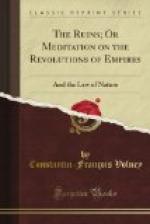“In the beginning, a sole-existent and self-existent God, having passed an eternity in the contemplation of his own being, resolved to manifest his perfections out of himself, and created the matter of the world. The four elements being produced, but still in a state of confusion, he breathed on the face of the waters, which swelled like an immense bubble in form of an egg, which unfolding, became the vault or orb of heaven, enclosing the world.* Having made the earth, and the bodies of animals, this God, essence of motion, imparted to them a part of his own being to animate them; for this reason, the soul of everything that breathes being a portion of the universal soul, no one of them can perish; they only change their form and mould in passing successively into different bodies. Of all these forms, the one most pleasing to God is that of man, as most resembling his own perfections. When a man, by an absolute disengagement from his senses, is wholly absorbed in self-contemplation, he then discovers the divinity, and becomes himself God. Of all the incarnations of this kind that God has hitherto taken, the greatest and most solemn was that in which he appeared thirty centuries ago in Kachemire, under the name of Fot or Beddou, to preach the doctrines of self-denial and self-annihilation.”
* This cosmogony of the Lamas, the Bonzes, and even the Bramins, as Henry Lord asserts, is literally that of the ancient Egyptians. The Egyptians, says Porphyry, call Kneph, intelligence, or efficient cause of the universe. They relate that this God vomited an egg, from which was produced another God named Phtha or Vulcan, (igneous principle or the sun) and they add, that this egg is the world. Euseb. Proep. Evang. p. 115.
They represent, says the same author in another place, the God Kneph, or efficient cause, under the form of a man in deep blue (the color of the sky) having in his hand a sceptre, a belt round his body, and a small bonnet royal of light feathers on his head, to denote how very subtile and fugacious the idea of that being is. Upon which I shall observe that Kneph in Hebrew signifies a wing, a feather, and that this color of sky-blue is to be found in the majority of the Indian Gods, and is, under the name of Narayan, one of their most distinguishing epithets.
Then, pursuing the history of Fot, the Lama continued:
“He was born from the right flank of a virgin of royal blood, who did not cease to be a virgin for having become a mother; that the king of the country, uneasy at his birth, wished to destroy him, and for this purpose ordered a massacre of all the males born at that period, that being saved by shepherds, Beddou lived in the desert till the age of thirty years, at which time he began his mission to enlighten men and cast out devils; that he performed a multitude of the most astonishing miracles; that he spent his life in fasting and severe penitence, and at his death, bequeathed to his disciples a book containing his doctrines.”




